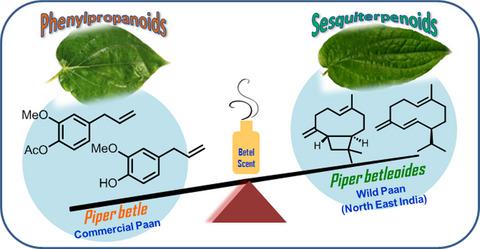当前位置:
X-MOL 学术
›
Flavour Frag. J.
›
论文详情
Our official English website, www.x-mol.net, welcomes your feedback! (Note: you will need to create a separate account there.)
Piper betleoides C. DC.: Edible source of betel‐scented sesquiterpene‐rich essential oil
Flavour and Fragrance Journal ( IF 2.6 ) Pub Date : 2019-10-07 , DOI: 10.1002/ffj.3537 Phirose Kemprai 1, 2 , Pranjit Kumar Bora 1 , Bhaskar Protim Mahanta 1, 2 , Dristi Sut 1, 2 , Siddhartha Proteem Saikia 1 , Dipanwita Banik 1 , Saikat Haldar 1
Flavour and Fragrance Journal ( IF 2.6 ) Pub Date : 2019-10-07 , DOI: 10.1002/ffj.3537 Phirose Kemprai 1, 2 , Pranjit Kumar Bora 1 , Bhaskar Protim Mahanta 1, 2 , Dristi Sut 1, 2 , Siddhartha Proteem Saikia 1 , Dipanwita Banik 1 , Saikat Haldar 1
Affiliation

|
Betel leaf or ‘Paan’ (Piper betle) is an integral component of the addictive chewing stimulant ‘betel quid’ which is traditionally consumed by a large population in the Asian countries. Betel essential oil is also heavily used by the flavour industries. Often, it constitutes of carcinogenic and genotoxic phenylpropanoids. High incidence of the oral carcinogenesis in this part of the world has been linked to the chewing of betel quid as well as Paan. In this study, Piper betleoides C. DC. (wild Paan) was identified as the edible plant source from north‐east India possessing betel‐scented essential oil which was highly rich in sesquiterpenoids majorly germacrene D and β‐caryophyllene. Identity of the plant was confirmed through critical taxonomic studies. Further, the essential oil yield and composition were investigated across different vegetative (young and mature leaves, stem) and reproductive (male and female inflorescence) tissues of P. betleoides through gas chromatography‐mass spectrometry (GC‐MS) and nuclear magnetic resonance (1H, 13C NMR) spectroscopic analyses. The comparative quantitative investigation showed a high dominance by sesquiterpenoids (>90%) in the leaves of P. betleoides with no detection of phenylpropanoids. On the contrary, a high level of phenylpropanoids (>75%) was found in P. betle (Bangla Paan). In effect, P. betleoides can be a potential alternative source of betel‐scented sesquiterpene‐rich essential oil.
中文翻译:

Piper betleoides C. DC .:富含槟榔气味的倍半萜烯精油的食用来源
槟榔叶或“潘氏”(Piper betle)是令人上瘾的咀嚼兴奋剂“槟榔”的不可或缺的组成部分,传统上在亚洲国家有很多人食用。调味品行业也大量使用槟榔精油。通常,它构成致癌和遗传毒性的苯基丙烷。在世界的这一地区,口腔致癌的高发与槟榔和潘氏鱼的咀嚼有关。在这项研究中,Piper betleoidesCDC。(野生Paan)被鉴定为来自印度东北部的食用植物来源,其具有槟榔香精油,其中富含倍半萜类成分,主要是胚芽戊烯D和β-石竹烯。通过关键的分类学研究证实了该植物的身份。此外,通过气相色谱-质谱法(GC-MS)和核磁共振法研究了甲壳虫的不同营养组织(幼嫩和成熟的叶子,茎)和生殖(雄性和雌性花序)组织的精油产量和组成。1 H,13 C NMR)光谱分析。定量比较研究表明,倍半萜类化合物(> 90%)在拟南芥叶片中占主导地位没有检测到苯基丙烷。相反,在甲壳虫(Bangla Paan)中发现了高水平的苯丙烷类化合物(> 75%)。实际上,贝氏疟原虫可能是富含槟榔气味的倍半萜烯精油的潜在替代来源。
更新日期:2019-10-07
中文翻译:

Piper betleoides C. DC .:富含槟榔气味的倍半萜烯精油的食用来源
槟榔叶或“潘氏”(Piper betle)是令人上瘾的咀嚼兴奋剂“槟榔”的不可或缺的组成部分,传统上在亚洲国家有很多人食用。调味品行业也大量使用槟榔精油。通常,它构成致癌和遗传毒性的苯基丙烷。在世界的这一地区,口腔致癌的高发与槟榔和潘氏鱼的咀嚼有关。在这项研究中,Piper betleoidesCDC。(野生Paan)被鉴定为来自印度东北部的食用植物来源,其具有槟榔香精油,其中富含倍半萜类成分,主要是胚芽戊烯D和β-石竹烯。通过关键的分类学研究证实了该植物的身份。此外,通过气相色谱-质谱法(GC-MS)和核磁共振法研究了甲壳虫的不同营养组织(幼嫩和成熟的叶子,茎)和生殖(雄性和雌性花序)组织的精油产量和组成。1 H,13 C NMR)光谱分析。定量比较研究表明,倍半萜类化合物(> 90%)在拟南芥叶片中占主导地位没有检测到苯基丙烷。相反,在甲壳虫(Bangla Paan)中发现了高水平的苯丙烷类化合物(> 75%)。实际上,贝氏疟原虫可能是富含槟榔气味的倍半萜烯精油的潜在替代来源。



























 京公网安备 11010802027423号
京公网安备 11010802027423号